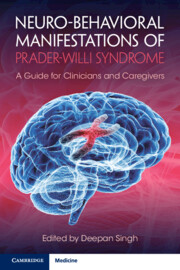Book contents
- Neuro-behavioral Manifestations of Prader-Willi Syndrome
- Neuro-behavioral Manifestations of Prader-Willi Syndrome
- Copyright page
- Dedication
- Contents
- Contributors
- Preface
- Acknowledgments
- Chapter 1 Knowing Your Patient
- Chapter 2 Caregiver Burden in Prader-Willi Syndrome
- Chapter 3 Establishing a Relationship with a Mental Healthcare Provider
- Chapter 4 Sleep Disorders in Prader-Willi Syndrome
- Chapter 5 Autism in Prader-Willi Syndrome
- Chapter 6 Anxiety in Prader-Willi Syndrome
- Chapter 7 Picking, Hoarding, and Elopement in Prader-Willi Syndrome
- Chapter 8 Attention-Deficit/Hyperactivity Disorder in Prader-Willi Syndrome
- Chapter 9 Agitation and Aggression in Prader-Willi Syndrome
- Chapter 10 Mood Disorders in Prader-Willi Syndrome
- Chapter 11 Psychotic Disorders in Prader-Willi Syndrome
- Chapter 12 Psychopharmacology in Prader-Willi Syndrome
- Chapter 13 A Caregiver’s Perspective
- Chapter 14 The Neurobiology of Prader-Willi Syndrome
- Chapter 15 Final Reflections on the Neuro-behavioral Manifestations of Prader-Willi Syndrome
- Index
- References
Chapter 2 - Caregiver Burden in Prader-Willi Syndrome
Published online by Cambridge University Press: 26 May 2022
- Neuro-behavioral Manifestations of Prader-Willi Syndrome
- Neuro-behavioral Manifestations of Prader-Willi Syndrome
- Copyright page
- Dedication
- Contents
- Contributors
- Preface
- Acknowledgments
- Chapter 1 Knowing Your Patient
- Chapter 2 Caregiver Burden in Prader-Willi Syndrome
- Chapter 3 Establishing a Relationship with a Mental Healthcare Provider
- Chapter 4 Sleep Disorders in Prader-Willi Syndrome
- Chapter 5 Autism in Prader-Willi Syndrome
- Chapter 6 Anxiety in Prader-Willi Syndrome
- Chapter 7 Picking, Hoarding, and Elopement in Prader-Willi Syndrome
- Chapter 8 Attention-Deficit/Hyperactivity Disorder in Prader-Willi Syndrome
- Chapter 9 Agitation and Aggression in Prader-Willi Syndrome
- Chapter 10 Mood Disorders in Prader-Willi Syndrome
- Chapter 11 Psychotic Disorders in Prader-Willi Syndrome
- Chapter 12 Psychopharmacology in Prader-Willi Syndrome
- Chapter 13 A Caregiver’s Perspective
- Chapter 14 The Neurobiology of Prader-Willi Syndrome
- Chapter 15 Final Reflections on the Neuro-behavioral Manifestations of Prader-Willi Syndrome
- Index
- References
Summary
Caregiver burden is multidimensional, adversely affecting the caregiver’s emotional, social, financial, physical, and spiritual functioning. Demographic risk factors for caregiver burden include female gender, low education, low socioeconomic status, and living with the care recipient. Psychosocial risk factors include caregiver depression and/or anxiety, lack of coping skills, and increased social isolation and decreased social activity for the caregiver. Caregiver burnout is a confluence of emotional exhaustion, detachment, or disengagement as a result of exhaustion without relief and the cynicism that can occur in a caregiver. Caregivers should be encouraged to make time for themselves. A peer group or PWS community can provide a safe outlet to discuss frustrations and emotional difficulties. Practicing mindfulness can reduce distress and increase resilience. When emotionally overwhelmed, caregivers can seek out a mental healthcare provider to help develop effective coping strategies. Healthcare providers can help reduce the risk of caregiver burden and burnout by assessing caregivers’ levels of stress and providing easier access to services.
Keywords
- Type
- Chapter
- Information
- Neuro-behavioral Manifestations of Prader-Willi SyndromeA Guide for Clinicians and Caregivers, pp. 8 - 17Publisher: Cambridge University PressPrint publication year: 2022



